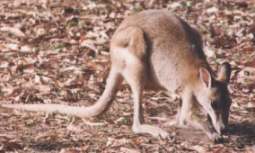Agile Wallaby

Photo: Courtesy of Damon Ramsey
BSc.(Zool) Biologist Guide
Agile Wallaby: Macropus agilis Distinguishable Features: 'Agiles' are distinguished by a white stripe that runs across the thigh. They also have a lighter stripe that runs along the cheek below a darker line from the eye, however, it is not as pronounced as it is on the 'Pretty Face Wallaby, Macropus parryi. Fully grown female Agile wallabies stand about 90 centimetres tall (Egerton 1997), while males may stand up to 1.4 meters tall (Strahan and Cayley 1995).
Distribution and Habitat: This is the most commonly seen kangaroo of tropical Australia. Agile Wallabies are found in the tropical top third of Australia and southern New Guinea. They are more common towards the coast, and start to thin out towards the drier interior of Australia, and the wetter interior of New Guinea. Within this range, they live in open forest and grasslands, usually not too far from rivers and streams (Strahan 1998). It's common status, wide geographic and ecological distribution is reflected in it's many different common names; Agile Wallaby, Sandy Wallaby, Jungle Wallaby, Kimberly Wallaby, Grass Wallaby and River Wallaby (Strahan 1997).
Diet: They are primarily grazers on native grasses, but are also recorded to browse on other plants and feed on native fruits from plants such as the 'Leichardt tree', Nauclea orientalis and 'figs' Ficus spp. (Strahan 1997). When conditions become drier, they can be observed digging into the soil to reach grass roots. Like other grazers, they are often attracted to areas of fresh grass that regenerate after fires in the tropics. No doubt, this behavior was exploited by the Indigenous people of Australia.
Behaviour: Like most kangaroos, they tend to snooze by day in denser vegetation, and come out to feed in the morning, afternoon and night. Like many of the larger kangaroos, Agile Wallabies are sociable animals. They are reported to move in groups of ten or so, and form larger aggregations in places of good feed (Strahan and Cayley 1995). Being common and prone to large numbers and aggregations, they are often considered a pest in much of their range, such as in the sugar can fields of North Queensland, and are subsequently hunted (Egerton 1997).
Breeding and Rearing: Females are ready to mate at a just over a year old, while males are mature a few months after that (Strahan and Cayley 1995). The males are substantially larger than the females (Strahan and Cayley 1995). They can breed continuously, and will do so if conditions are right, with the females being capable of embryonic diapause (Strahan and Cayley 1995). The gestation period is about a month (Strahan 1997). The joey stays in the pouch for about 7 to 8 months, and is weaned off in 10 months to a year (Egerton 1997).
Script: Courtesy of Damon Ramsey BSc.(Zool) Biologist Guide |
